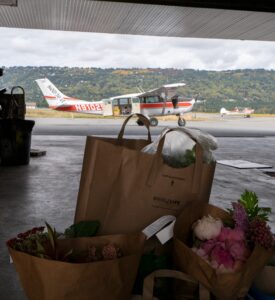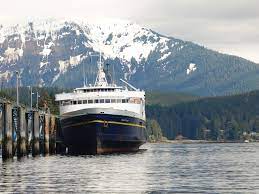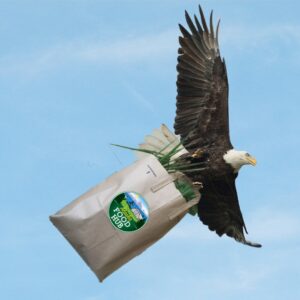Alaska is the largest state with a cadre of transportation challenges and innovative solutions.
The majority of communities are dependent on air and water to transport people, vehicles, and goods, including food and basic supplies.
The current food system is highly vulnerable given its dependence on a lengthy supply chain that imports foods from producers and distribution centers in the lower 48 states. Threats to this food supply chain include natural disasters (wildfires, earthquakes, tsunamis, drought, flooding), food safety recalls, transport interruptions due to weather or mechanical failures, political upheaval, and/or terrorism. More recently, the COVID-19 pandemic led to shelter-in-place precautionary measures at the national, state, and community levels in March 2020. Continued uncertainty around the long-term health and safety of food workers in the lower 48 may lead to even more supply shortages and interruptions in the future.
Food hubs are a logical way to increase localized food production in Alaska and improve the distribution of regional food products to their communities. A food aggregation hub is a clear way to build a regional food economy by establishing a regional network to empower local producers, especially in rural communities, to access a larger consumer market.
Transportation is one of the most critical challenges to overcome for food producers if their goals are to grow their operations and access larger urban markets. Instead of accepting the current limitations of the transportation system, building a regional food economy will rely on developing innovations based on diversified, decentralized, relationship-based, and community-centered approaches. In addition to developing alternative transportation networks, we can better utilize existing ones.
Existing transportation systems include:
- Airlines: local, regional, and national
- Railroad
- Highways (deliver vans, refrigerated trucks)
- Ferrys (Alaska Marine Highway)
- Food hub-owned or contracted delivery vans
Additional considerations:
Road travel: Some food hubs are large enough to utilize refrigerated trucks (for example, Arctic Harvest Deliveries) or insulated containers capable of maintaining consistent temperatures below 41°F, especially during long journeys. This will help keep produce and other food products fresh, removing heat from the field that can contribute to spoilage. Most likely you will have producers driving their own trucks or non-commercial vehicles to the distribution site. Consider helping your producers coordinate and combine product deliveries into one vehicle if transporting from one farming region with several farms to the food hub. Larger food hubs also often buy a van or other appropriate vehicle to help with deliveries and transportation.
Air travel: Consider partnering with airlines offering cold storage capabilities for perishable items. Chilling food prior to air shipping canhelp maintain safe temperatures during transport. Many parts of Alaska use air cargo on seaplanes and bush planes for transporting food between communities (for example, Alaska Food Hub transports orders to Seldovia this way). Reaching out to these companies and learning how to safely transport food with them can be essential for gaining a wider reach of both vendors and consumers, expanding food security to more remote areas.
Marine transport: Explore the feasibility of using the Alaska Marine Highway (Ferries), other regional ferries, or barges for coastal communities. Water taxis may also be utilized. Southeast Alaska in particular can rely on regular marine transport as an economic (but often slow) way of moving produce. Research temperature-controlled options and ensure proper packaging to withstand potentially turbulent conditions of weather and seas during transportation. Barges often have one-way trips to rural areas so if you can find a rural producer that wants to ship back to a more urban area with a larger market that can help make it even more economically feasible. Sometimes barges and other local companies will even donate their space to smaller food producers as a way of supporting food security in their communities. Don’t be afraid to ask and explain the economics of small food production and why you are building a food hub to support it!
Seasonality: Account for seasonal fluctuations in weather and adjust transportation methods accordingly. Winter months may require additional insulation or heating solutions. Summer transport likewise might have similar issues such as un-refrigerated shipping containers or barges reaching very high temperatures.
Remote locations: Utilize partnerships with local transportation providers familiar with the unique needs of rural communities. There are often regular grocery + supply runs to larger communities from more remote ones that you can start participating in. This often requires going to those communities or having a representative meet with you to build that relationship. Deliveries to these communities might require very unique transportation methods such as ATVs, personal boats, and snowmachines.
Fuel costs: Strategize efficient routes and consolidate deliveries to minimize fuel consumption and associated costs for both producers and consumers. Consider developing alternative pick-up points organized by neighborhood, region, or community to increase participation.


